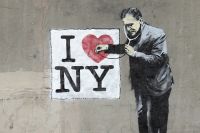Banksy and other graffiti artists are gaining increased commercial acceptance in the traditional art world. The Los Angeles Museum of Contemporary Art recently had an exhibition called Art in the Streets featuring artists such as Banksy and others. But whether such artists’ works are protected by the Copyright Act, among other legal doctrines, is unclear. There is paltry case law on point. We recently found this out when researching the issue for a somewhat famous — or some might say infamous — New York graffiti legend.
The Copyright Act generally protects creative works fixed in a tangible medium. Song lyrics are a good example. When Bob Dylan writes his song, All Along The Watch Tower, on a piece a paper, he can register the song with the Copyright Office. Only then can Mr. Dylan can than pursue others for using the song unlawfully. Many federal courts require a work to be so registered before suit can be brought by the artist for damages, attorney’s fees, and statutory damages.
But what about creative works that are fixed by graffiti artists all around New York City’s walls and subways? Assume Banksy paints the picture above on a Fifth Avenue wall. Could he then go and register the work with the Copyright Office, just as Mr. Dylan did with his song? Even if he can’t, does that mean Bansky has no legal protection? The questions are simple. But the answers are not so clear. cryptocasinohk.com
There are no cases directly on point. There is one case from the Northern District of Illinois, entitled Villa v. Pearson Education, Inc., in which the court denied the defendant’s motion to dismiss the graffiti artist’s copyright infringement claim because there was an issue of fact whether his art was illegal. There is also another case pending overseas between graffiti artist CanTwo and the Spanish Olympic Committee, reports the Wall Street Journal in CanTwo Says “Can Not!” to Spanish Swimmers. But that case is not yet decided and it involved apparently legal graffiti.
While this uncertainty is troubling, a graffiti artist should nonetheless be able to argue that a gallery is unjustly enriched when they sell a photo of his work but don’t pay him even if he does not have a copyright claim. That’s because what is good for the goose is good for the gander. If a gallery is going to commodify the artist’s graffiti efforts in a secondary market, it will be hard pressed to argue that the artist has no rights in the primary market because the work was illegal.

